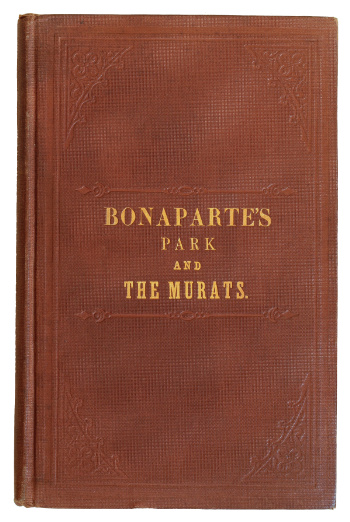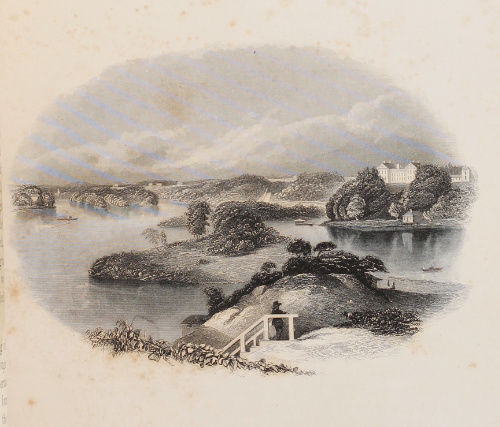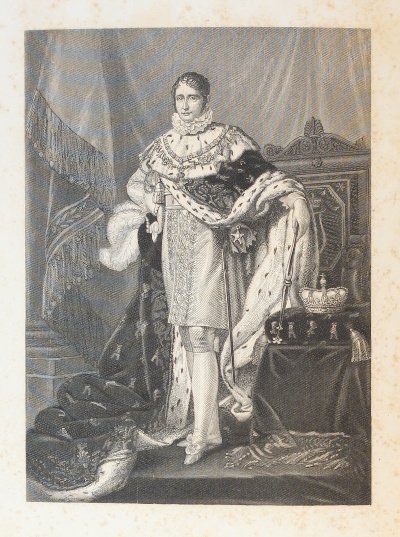A HISTORY OF JOSEPH BONAPARTE’S POINT BREEZE ESTATE AT BORDENTOWN, NJ,
WHICH REPUTEDLY HOUSED THE LARGEST LIBRARY IN THE UNITED STATES
WOODWARD, Evan Morrison. Bonaparte’s Park, and the Murats. Trenton, NJ: MacCrellish & Quigley, 1879.
Octavo (230 x 143mm), pp. 116, [2 (advertisement for other works by Woodward)]. Mezzotint portrait frontispiece and engraved plate. (Offsetting from frontispiece and plate onto text, some spotting on engravings, occasional light marks.) Original ochre cloth gilt, boards with borders of blind rules with cornerpieces, upper board lettered in gilt, spine lettered in gilt, brown coated endpapers. (Extremities slightly rubbed and bumped, traces of historic label on lower board, lower hinge partially split.) A very good copy in the original cloth.

First edition. E.M. Woodward (1838-1904), who served as a First Lieutenant and Regimental Adjutant in the 2nd Pennsylvania Reserves during the American Civil War, was awarded the Medal of Honor for his role in an action at Fredericksburg, VA on 13 December 1862. After the Civil War Woodward moved to New Jersey, where he remained for the rest of his life and published a number of works on American and military history, including Bonaparte’s Park, and the Murats, a history of the Point Breeze estate in Bordentown, NJ.
Napoleon’s brother Joseph Bonaparte, comte de Survilliers (1768-1844), had fled to America in 1815, following Napoleon’s defeat at Waterloo and the fall of the empire, and in the same year acquired various pieces of land near Bordentown, which he added to over the following two decades until the estate of Point Breeze (popularly known as ‘Bonaparte’s Park’) covered some 1,800 acres. In 1816, Bonaparte built a large manor house at Bonaparte’s Park, which was the home to his remarkable collections of artworks and books – indeed, his library was reputedly the largest in the United States. In about 1820 he also built The Lake House, which would be home to Bonaparte’s daughter Zénaïde (1801-1854) and her husband, her cousin Charles-Lucien Bonaparte (1803-1857), for some years after they emigrated to the United States in 1822.

Bonaparte’s Park, and the Murats is composed of articles that Woodward had contributed to the Bordentown Register, which brought forth further information about Joseph Bonaparte’s life in the United States – thus allowing ‘the addition of much new material, kindly furnished by the citizens and correspondents in various parts of the country. We feel ourselves under many obligations to Mr. Adolph Mailliard, the son of King Joseph’s faithful secretary, for deeply interesting and authentic information never before given to the public; to Mr. Bellemere, a member of his household, for carefully going over with us the manuscript; […] and to the many citizens of Bordentown who have furnished us with the reminiscences of the Count and his family’ (pp. 19-20). In his introduction Woodward proposes that Joseph Bonaparte’s role in the creation and government of his brother’s empire meant that a ‘deep interest is attached to his personal character and career’, and that the ‘opinion, so popular, that Napoleon was the only extraordinary member of the family, is erroneous. […] But if, in the present day, a man existed, who, as a diplomatist, soldier and king, had distinguished himself by his wisdom and brilliant qualities, had gained battles and worn two crowns, was distinguished for his patriotism, had never broken faith with friend or foe – that man would hold a high place in public estimation, and would be called great’ (p. [21]).

A contemporary reviewer wrote of Bonaparte’s Park, and the Murats that it ‘gives an interesting description of the beautiful home of Joseph Bonaparte […], which he built at Bordentown, after the downfall of Napoleon […]. It also contains interesting reminiscences of King Joseph during the time he resided in the United States, and of Prince Murat, the son of Marshal Murat. It is gossippy and pleasantly written, and will be read with interest’ (The Pennsylvania Magazine of History and Biography, vol. III (1879), p. 471).
Bradford and Henkels, The Bibliographer’s Manual of American History, 6010; Wolschke-Buhlman and Becker, American Garden Literature in the Dumbarton Oaks Collection, 404.
£79.50
· · · · · · · · · · · · · · · · · · · · · · · · · ·
Our Terms & Conditions apply.

